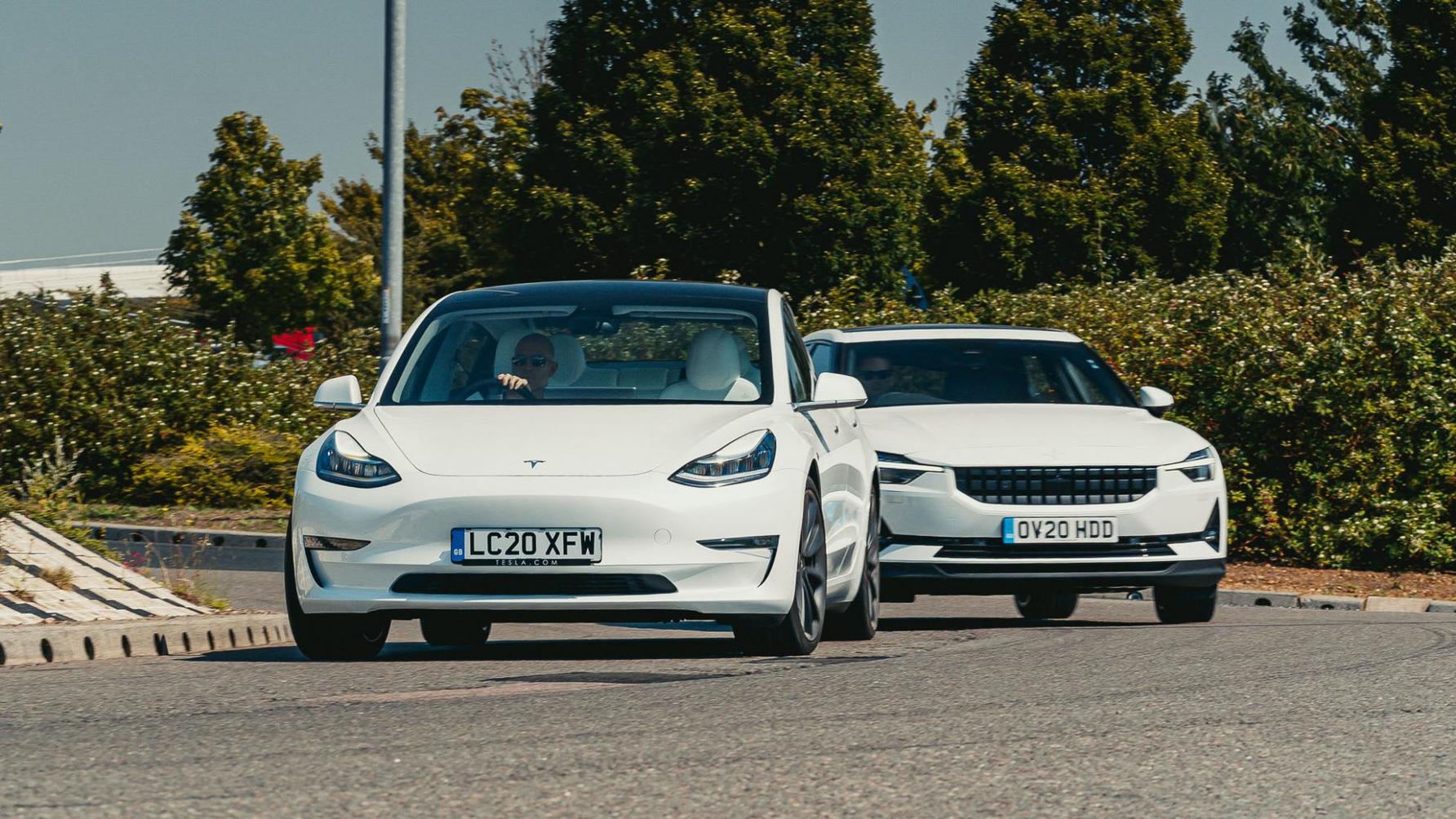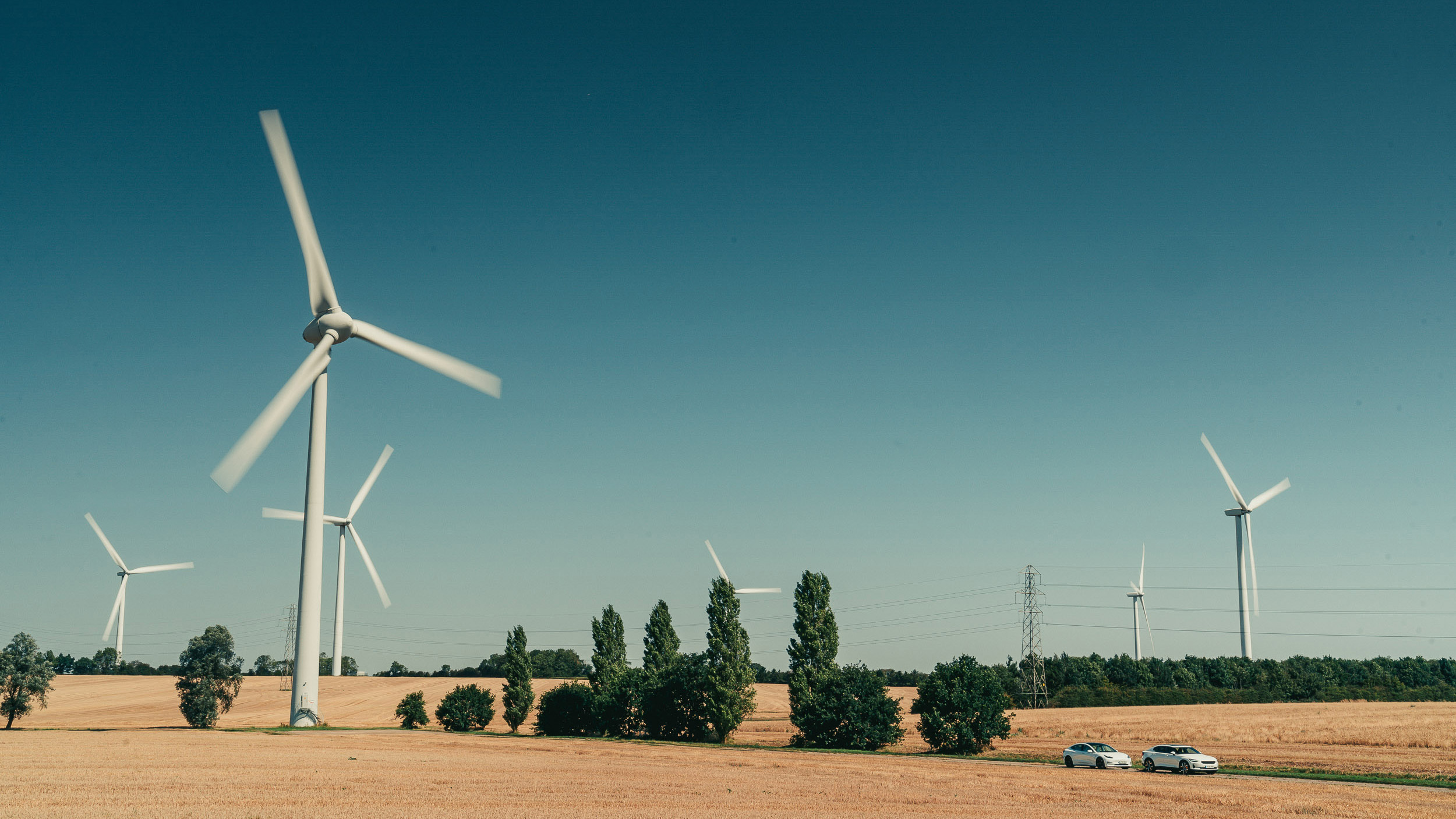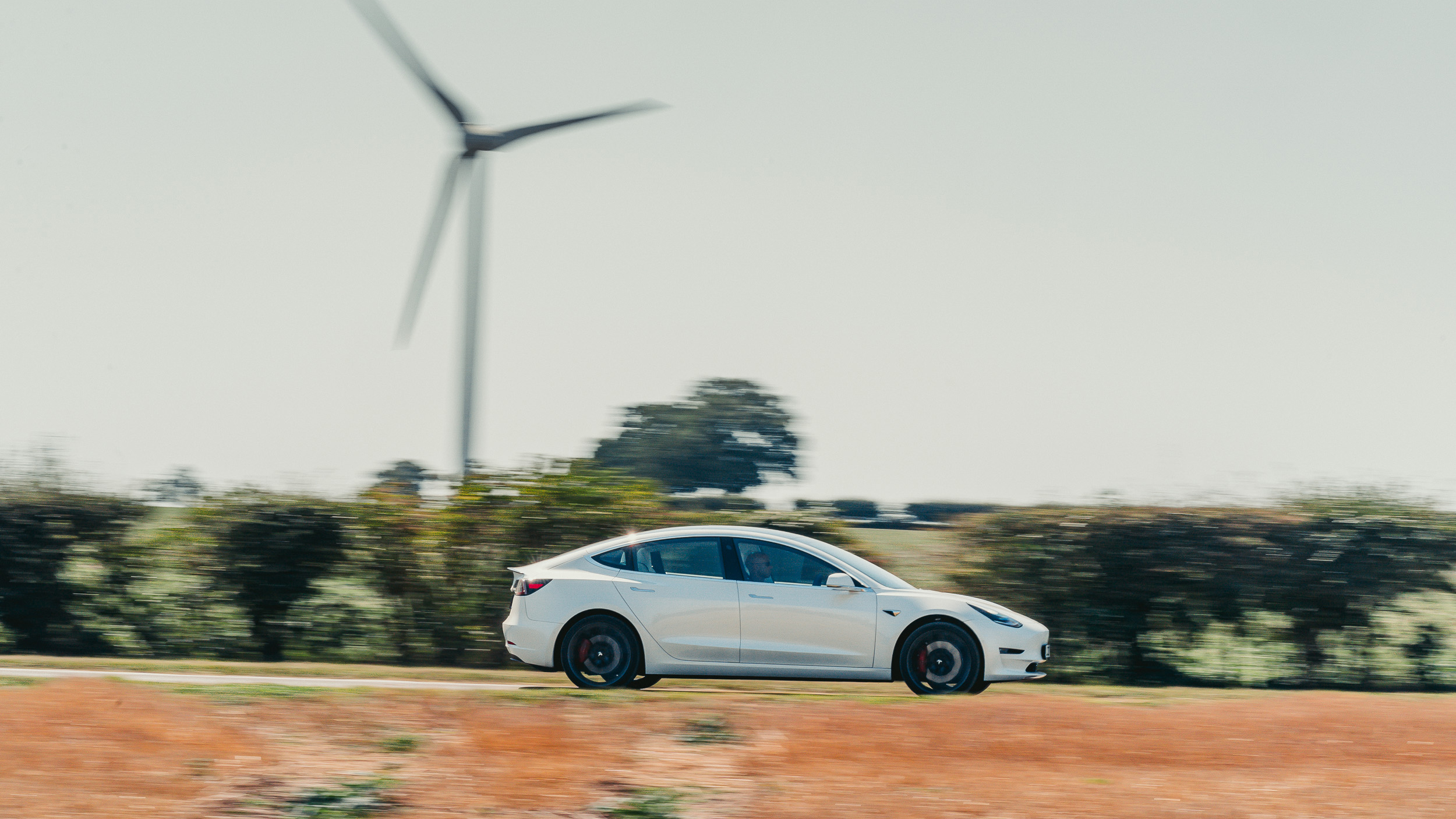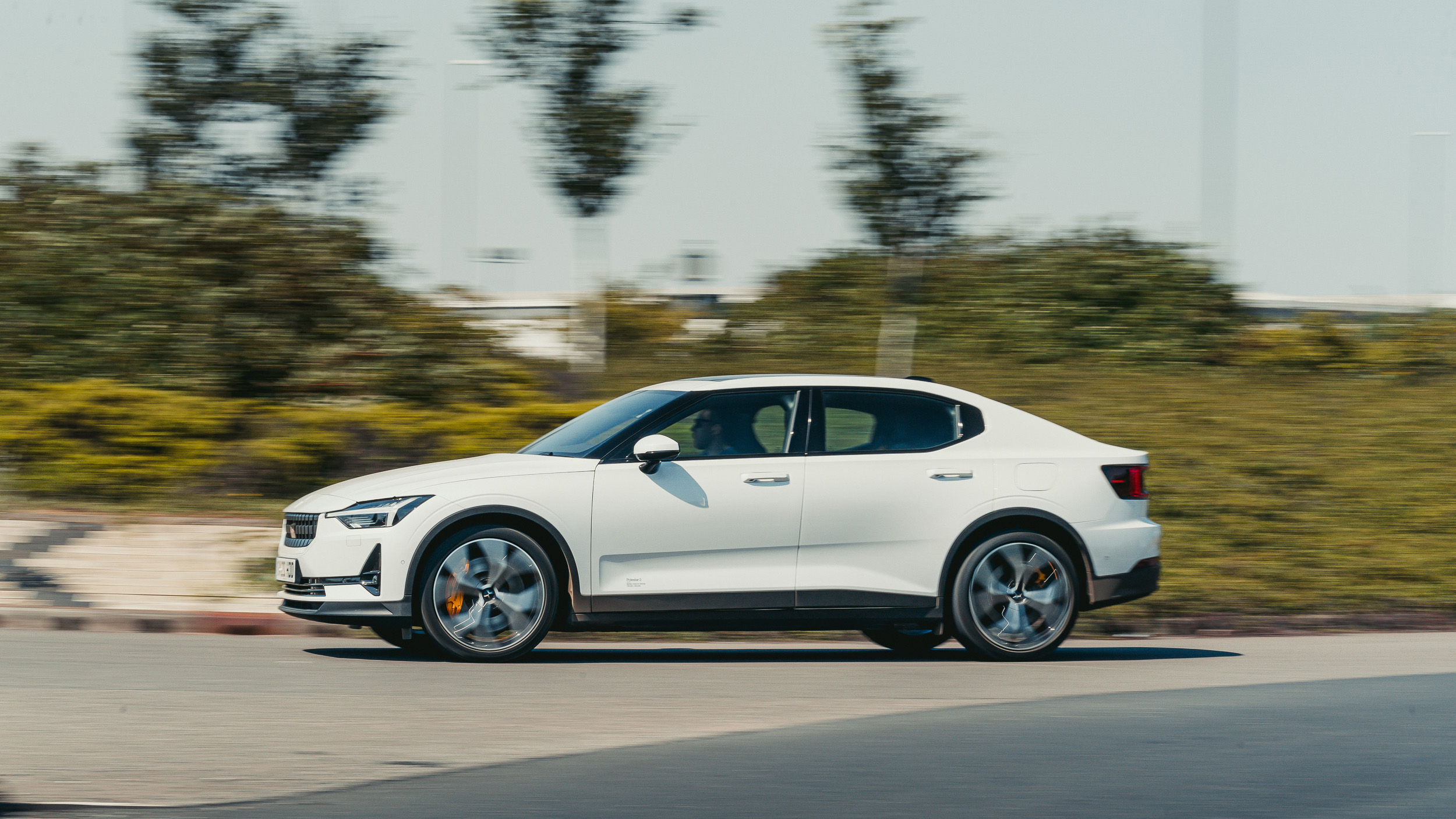
The big electric test: Polestar 2 vs Tesla Model 3
It's the EV battle of the numbers, as Sweden's 2 takes on America's 3
Here we go then, Polestar 2 against Tesla 3. The 2 you see here is equipped with the £5,000 Performance Pack. Similarly the 3 is a Performance version for full-whack-in-the-back go. This means they’re both around £55k or about £700 a month on PCP. I don’t want to lead your decision making, but you don’t need (or even want – we’ll discuss further on) your Tesla to hit 60mph in 3.2secs – 4.4 is still plenty fast enough. And you don’t want or need Polestar’s Performance pack with its big wheels, manually adjustable Ohlins dampers and gold trimmings. Gold dustcaps, Polestar – exactly how long do you think it’ll be until some oik has those away?
Take a step down to the 3 Dual Motor Long Range AWD and the plain 2 (other versions will come, and with them bulkier names) and you’re set: £46,990 Tesla plays £47,800 Polestar, with PCP deals available through each firm for under £600 a month. Both place a motor on each axle for an all-wheel drive total of 346bhp (Tesla) and 402bhp (Polestar). Yes, this Tesla is the 450bhp Performance, and it pulled an easy ten lengths on the Polestar off every roundabout or away from each village, but we found ourselves driving it in power-reducing Chill mode most of the time, simply to escape the sudden, neck-straining step-off every time we gently pulled away. It’s very eager. Even in reverse, which is a bit disconcerting. Chill mode smoothed the throttle nicely and still made the Polestar work hard to keep pace.
Between the axles both sling a plate of lithium-ion batteries – 75kWh of them for the Tesla, 78kWh in the Polestar. Yet the Tesla has easily the longest claimed range: 348 miles plays 292 miles. Over the course of 500 miles, the Polestar’s electric consumption was 35.7kw per 100 miles, the Tesla’s 28.4kw/100miles, or expressed more simply: a range of 220 miles in the Polestar, against closer to 270 miles for its rival. You might be wondering why this is since both are a very similar size.
Two main things at work here of which aerodynamics (a super low drag of 0.23Cd for the Tesla plays a still good 0.28Cd) is the less important. Weight. The Polestar is a hippo. 2,123kg, some 270kg heavier. This is because it’s based on an existing internal combustion platform – you didn’t expect that did you? – Volvo’s CMA architecture that also underpins the XC40. It’s steel with steel panels, too, where the 1,847kg Tesla does at least use some aluminium as well as being designed to be electric from the outset.
The Polestar doesn’t feel heavy on the road. As with almost all electric cars the weight is carried low down, and as with almost no electric cars, this Performance Pack wears a set of Ohlins adjustable dampers. If you put the steering on full lock, you can lie on your back under the front wheel, twiddle the knob at the base of the suspension turret and choose whichever of the 20 positions you’d like. You can do the same at the back as long as you remove the wheelarch liner first. Answer me this: who the cocking hell thought this was a good idea? It was acceptable on the Polestar 1, because it was a limited edition 600bhp super GT. There it was quirky – and accessible under the bonnet/back wheel. Here, on a mainstream EV, it’s just pointless.

Now, I don’t know how the 2 rides as standard. But with them, it’s too taut in just about all positions. Yes, the damping is lovely if you like fast, precise, controlled movements, so feel free to coo about the engineering involved, but everyone else in the car will look at you like you’re mad and wonder why a high-rise car is so firmly sprung around town. You’ll explain that Polestar sees itself as a performance brand, and again everyone else will look at you like you’re mad because they’re sitting in a square-edged, family-orientated crossover. The end result of all this will see you lying flat on your back on your driveway at home and having another twiddle, while your neighbours make sympathetic faces at the rest of your family.
Nevertheless, dynamically the 2 is still better than the 3. The softer sprung Tesla gets a bit jiggled from side to side and doesn’t have such impressive body control, and the American car’s steering is pretty nasty – it has this initial resistance that fades as you turn, which is disconcerting, and seems to operate a heartbeat after your input. It doesn't give you confidence, and makes it tricky to place the car on the road accurately, a feeling that is exacerbated if you try to drive quickly. Sure, it’ll scoot around roundabouts and fire off into the distance, but you’d never describe it as sporty or involving, just effective.
The Polestar is better. You can select lighter or heavier steering, but both are worse than leaving it alone where it’s actually nicely weighted and accurate. Turning circle isn’t great, though. There’s a consistency to the controls (steering and pedals) that’s reassuring – they’re not as instantly responsive as the Tesla’s, but feel meatier and more satisfying. I’d still like the whole car to be more comfort-focussed though. Plusher suspension would make the driving experience more serene. As it stands the Tesla rides more comfortably, and that matters.
In essence though, and compared to anything with a combustion engine, both do a grand job. They cruise silently, accelerate smoothly and are effortlessly easy to drive. Coming from something like an Audi A4 or Nissan Qashqai? You’ll love these. Compelling simplicity, matched by sleek, clean cabins, convincing tech and low running costs make them lovely things to spend time with. They feel advanced and futuristic, and both make claims about being able to drive themselves.
Top Gear
Newsletter
Thank you for subscribing to our newsletter. Look out for your regular round-up of news, reviews and offers in your inbox.
Get all the latest news, reviews and exclusives, direct to your inbox.
Never forget that they’re crap at it. It’s true of all cars that claim some level of autonomy. They’re furiously myopic, can see only one car ahead, can only react, not predict, have no nuance or knowledge. Now, within the boundaries they’re allowed to operate in, both are good. Massive central touchscreens do drag your attention away from the road and knowing the car can hold a position in its lane a set distance behind the one in front is useful. Both Tesla’s Autopilot and Polestar’s Pilot systems do that very well. Notice the terminology, though – both surreptitiously hinting you can hand over responsibility.
Tesla goes further, and for £6,800 offers Full Self-Driving Capability. Sigh. It’s nothing of the sort. It’ll make amateur hour lane changes several seconds after you wanted them and navigate through major motorway intersections. Maybe this works well in America, but in crowded Britain it soon gives up. And Tesla has rowed back on hands-free. A few years back it was amazingly permissive, but now beeps an alert after a few seconds, just like the rest. In time the tech will improve of course, and it’s worth knowing you can fit Self-Drive later (although the price might have increased) and that no-one else currently has features such as Summon. Tesla thinks boldly, differently and fortune favours the brave.
And the far-sighted. Charging infrastructure. This is why you should be most tempted by the Tesla, why you’ll overlook the froggy front end and evangelical Musk-ateer image. Because Supercharging rocks. Mostly you’ll charge at home, because that’s where it’s going to be cheapest, but the convenience and integration of Tesla’s own network is brilliant. On a long trip? Your car knows when to stop most efficiently, which chargers are free and how long you’ll be there. And with built-in Netflix, fart modes and video games, it’ll keep you occupied while you’re there. Which won’t be for long, since you’ll be taking electricity on board at a rate of 400 miles per hour.
Polestar is trying hard, but it’s paddling in the wrong pond. It’s teamed up with Plugsurfing, so you have a fob that gives you access to the vast majority of chargers, but you’re likely to pay more (c35 pence per kwh, against 24) and the rate of charge is likely to be slower – about 130 miles per hour on the most common 50kWh charger. Both can be driven a long way, but one of them is likely to lower stress levels better than the other.
Both have feelgood, minimalist cabins. Has Tesla taken it too far, doing away with the dashboard entirely and putting everything on a laptop screen? No. The crucial speed reading is top right and easily seen, and there’s a sense of calm to the open, airy dash and clear, white screen. The Polestar isn’t a full clean sheet design. It’s still got some legacy carryover from other Volvo models (and a couple of bits of switchgear). Nothing wrong with that, Scandi design is welcoming, attractive and thoughtful. The screen is good, it’s all logical and doesn’t try to pack too much functionality in. Personally I’d like a bit more trip info and graphics, while Apple CarPlay isn’t integrated until next year (Android only to start with, although it’s done well). But you feel good in here, you feel safe, sunk deep behind a high shoulder line.
And it is beautifully made. This is a big area of contrast between the two. The Tesla feels slightly cheap and flimsy in comparison, the flatter seats are less supportive, the materials are less tactile and, on our test car, one of the doors stuck and the steering column jerked sideways when it was adjusted. The Polestar feels the nicer, more upmarket product.
Coming from something like an Audi A4 or Nissan Qashqai? You’ll love these
Worth knowing that both have vegan cabins (fake leather) and neither has good rear visibility – the 2’s rear window is cramped, the 3’s back deck is so high cars get lost below it. And knowing how good the Swedes usually are at driver comfort, why is there nowhere proper to rest your left elbow? The armrest doesn’t come forward far enough – although the flat-topped gearknob is a good wrist-rest while screen-prodding.
The Polestar offers passengers more leg and headroom and the versatility of a proper hatchback boot. The figures say the Tesla’s is bigger (425 litres against 405), but the 2 supplies a load divider, straps, hooks, an underfloor cubby and so on, ensuring your weekly shop won’t spread itself about on the way home. Having a hatchback is just more versatile and useful.
You can tell the Polestar was developed with both eyes on the Tesla. There’s no start button, you just tug the gearlever to get going, mapping is integrated with car systems to help with charging and all the infotainment and heating and everything is buried in the screen (which is a hassle on both sometimes – although the Tesla’s screen is better at multi-functioning). But the Polestar wraps you up and encloses you, while the Tesla empties the dash to give you the most panoramic view possible.
If you want one now, Tesla is quoting a delivery in about six weeks, Polestar four months. This is the start of the line for Polestar, less powerful versions will be along – including Volvo’s own XC40 Recharge (a full EV), built on the same platform. But the Polestar is a curiously compelling car. People wanted to know about it, they were intrigued by it and loved the way it looked. It attracted huge attention. It’s a styling masterclass for the way it slips between conventional classes and oozes desirability while basically having the proportions of yet another crossover. It’s positioning means it asks interesting questions of the more expensive Jaguar I-Pace amongst others. The badged mystified many – at the wind farm someone assumed it was a car built by the same firm that made the turbine blades. Someone else asked why Citroen had been fooling about with their badge.
The Polestar experience is still very Volvo – and there’s nothing wrong with that. No Volvo drives as well as this, nor oozes more Scandi calmness and cool. It’s pure hygge. I know this is less than analytical but I love what it stands for, what it looks like, it’s the one I’d rather be seen driving and yet… the Tesla wins. Given a straight choice between the two, that’s the one I’d drive away. Nothing to do with its speed or autonomy – the two things usually championed by the Teslarati – but because of its ease of use, efficiency, the supercharger network. It’s the more complete mode of transport.
But the Polestar is still a very fine car. If I needed its extra practicality or just wanted it more, I wouldn’t hesitate. It not only runs the Tesla very close, but I’d have it over just about any other family car from a Range Rover Velar to a BMW 3 Series. Polestar is here, it’s serious and it works. You’ll want one. But you’ll probably find the Tesla works better for you.










